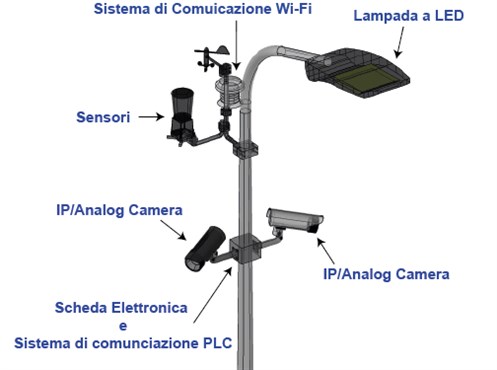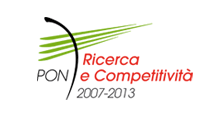Results to date: 16/07/2014
SEGUI IL PROGETTO
The project is focused on optimal management of public lighting and urban viability through the creation of a system of monitoring whose objectives concern the reduction of energetic consumption deriving from incorrect use of the public lighting system and the optimisation of urban viability.
To reach the objectives of the project, we propose to create a prototype which envisages the planning/creation of "intelligent" public lighting poles.
The "intelligent pole", through monitoring of urban viability, will be capable of guaranteeing constant control of the lighting flow, depending on the presence of vehicles and/or pedestrians in the area concerned, with the aim of obtaining a reduction in energy consumption.
The architecture of the system is based on the commitment of survey instruments (video-cameras and sensors), which provide information in real time regarding pedestrian and vehicular traffic and the level of ambient lighting.
The architecture proposed is configured as follows:
- Remote sensors: responsible for the measures of parameters such as the level of ambient lighting;
- Remote telecameras: responsible for the constant monitoring of the level of pedestrian and vehicular presence in an area of interest;
- LED lamps and Dimmer charger: the LED lamps represent an alternative eco-compatibility of high quality to the incandescent lamps currently used in business. The use of these will allow a significant reduction in costs, both in terms of reduction in consumption, and in terms of increasing the average lifespan of the lamps. These furthermore allow a reduction in CO2 emissions.
- PLC (Power Line Communication) communication system: technology for data transmission which makes use of the electric fuel network. Its use is aimed at the exchange of information between remote posts ("intelligent poles") and a centralised system ("automatic system of data processing and remote control").
- Automatic system of data processing and local/remote control: system that manages and processes exchanged information, through PLC, between the nodes (poles).
- UMTS communication modules: technology that manages the exchange of information between the "local nodes" and the centre of remote data processing.
- Wi-Fi communication modules: technology which, in the presence of a system of public Wi-Fi, allows the "local node" to be used as a point of Internet access.
- System of environmental monitoring.
The results of this project consist in the study and creation of a prototype system which implements a system of supervision, monitoring and control distributed on broadband data networks, aimed at reaching two main objectives:
- The first objective is that of identifying a control strategy and a corresponding telematic infrastructure for the exchange of information between the various network nodes to create an adaptive and integrated system of remote management of the "lighting system" of a complex territorial context (a Municipality, a District, etc.) with the capacity for monitoring events of possible interest, adaptation to the varied conditions of light and traffic and with auto-diagnostic functions with respect to breakdowns and malfunctions. In terms of energy efficiency the desired objective to reach is to minimise the energy used for public lighting with regard to minimum lighting limits imposed by applicable legislation.
- The second objective is that of the development of a methodology of measuring traffic data and other information (quantification of the passage/presence of people and vehicles, ambient light, etc) with hourly, daily, weekly, monthly and annual cadenza, based on the processing of video images captured by telecameras positioned at light points at very low cost. The data collected will then be elaborated to determine provisional models of the profile of use in the short and long term, to verify the achievement of the services and generate appropriate counter-measures from the control system.
A fundamental role of the project is undertaken by the " intelligent pole ", an innovative product which as well as being a source of lighting is a multi-sensor system for environmental monitoring, the management of lighting flow and more (see Figure 1). Among the sensors indicated the telecamera takes on a fundamental role from both the functional and innovation points of view, indeed allows the observation in a non-invasive way of the flow of vehicular and pedestrian traffic and potentially the ambient lighting.
 Figure1: The
intelligent pole
Figure1: The
intelligent pole
The results so far achieved have allowed the definition of the algorithms for the supervision and monitoring of traffic, as well as the algorithms for the identification of particular events such as accidents or anomalous traffic situations. Algorithms have also been defined for the optimisation of traffic light management.
The technological infrastructure and the sensor network of reference have been defined and the electronic board is in development on which algorithms will be implemented for the adaptive regulation of lighting flow and the data exchange system between the network nodes and the control platform.
Also in development are activities concerning the development of the algorithms above, on a DSP platform and the development of the remote control platform.
The study and calibration of sensors, the aspects tied to the management of the images and videos and those tied to regulation in the photometric and illumino-technic field have been completed and the appropriate scientific report has been drawn up.
- Go to presentation
http://www.slideshare.net/abbia18/smart-pon04a3-00402-32499145
- Go to presentation video
http://youtu.be/_6_WnKBexVU






 Storify
Storify twitter
twitter YouTube
YouTube
